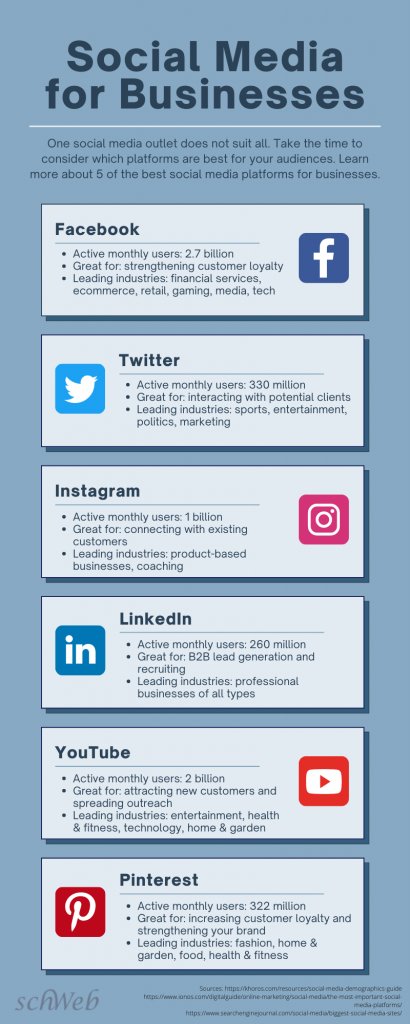There’s many things to consider when putting your company’s face on the web. Odds are, if you’re thinking about making a website for your company, you’re also thinking about social media.
What Is Social Media?
Most people have come across a social media site or two at this point. For starters, there’s Facebook, where you can create a page for your company. Twitter is probably the next most well-known, where you can post tiny blips about your company’s news, products, and so on.
There’s also Instagram, where you can post picture-centered posts. And there’s Pinterest. And LinkedIn. And map sites, like Google Maps. Review sites like Yelp. And…well, you get the picture.
There’s a lot of options out there, and what you choose is mostly based on your needs. While the way you share information on any platform differs hugely, what makes these all similar is what they do. And that’s bring people together under a common theme. If you’re doing it right, that common theme on any social media platform is your company.
Why Does My Company Need Social Media?
There’s numerous reasons why your company should be involved in social media. Levick, a communications company that’s won numerous awards in marketing and public relations, boils it down to this:
“Social media is essential for companies, especially consumer-facing brands, because of the consumer’s need for increased transparency and accountability. Having a social media strategy in play, which heavily focuses on social media communication, can significantly increase awareness of your brand, engage a new audience, or even diffuse a communications crisis that can affect your company’s bottom line.”
Social media is a strong, and relatively cheap, way growing customer relationships and marketing yourself, your company, and your products to a virtually limitless audience. An audience which, shockingly, is becoming increasingly social media savvy.
Social media shares information from user to user, starting with you. When a post, or an image, or a video, is sent out into the internet, one person shares it. Then that person’s friends see it, and maybe they like it, or pin it, or maybe they share it, too.
The methods may differ, but the take-away is this: social media encourages people to share with their friends and family, and friends and family are probably more likely to purchase designer shoes vetted by people they know over people they don’t.
Additionally, social media is alive. Not alive like you or me, maybe, or like Frankenstein’s monster, but alive in the sense that it’s continually changing and evolving. And that process doesn’t take ten billion years. It happens fast.
Speed of communication is a significant factor in selling a product or service. Social media allows you to engage your key audiences faster and more easily than ever before, and that close interaction will likely show a difference in your bottom line.
However, a huge part of effective social media is developing a strategy. Here, Schweb offers SEO services that can help get you closer to your marketing goals, identifying keywords, trends, and content ideas that will help you engage and encourage your audiences. And, like we saw earlier, the chatter on social media happens fast, so we can tailor your SEO service to either a monthly or weekly format.
Which Social Media Platforms to Consider
One social media outlet does not suit all. Take the time to consider which platforms are best for your audiences.
For instance, consider Twitter. Consider your audiences when you think about what platforms you choose. Twitter might be a great way to approach customers who are in the twenty-somethings age bracket. This group of young adults aging from 18 to 29 years old accounts for 31% to 37% of all adult Twitter users.
That information is great if you sell, for instance, smartphone cases or college dorm supplies. But if your clients are more likely to be just a little older, you may want to look to another platform, since membership drops off significantly after age 30. Maybe you should focus your efforts on Facebook, instead, which accounts for 79% of adults aged 30 to 49.

Using Social Media Effectively
This could easily be a discussion for books’ worth of information. But to keep it simple, social media doesn’t purely exist to repost content from your blog, although that can be perfectly acceptable depending on your needs, the audiences, and how spectacular the blog content is.
Social media demands a different approach. It’s not one-way communication. Its power and beauty is in its ability to create dialog between you and your audiences.
It’s about engaging your audiences on the things that matter to them. Enter into conversations with your followers on Facebook and Twitter – ask them what they enjoy about your company or product. Share your followers’ photos they took at your golf course.
However you choose to grow your social pressence, never forget that it’s your relationship with your audiences that matters, not just your product. Let them know it.
